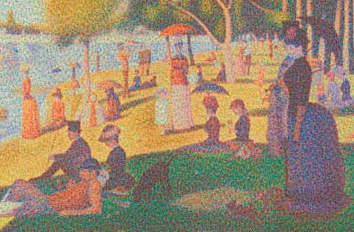Chris Jordan: Paparazzi of Garbage
by Amy Curtis | July 13, 2011

In an October 2007 interview, artist (and former New Dream board member) Chris Jordan sat down with comedian Stephen Colbert and jokingly referred to himself as a “Paparazzi of Garbage.” Despite these playful remarks, Jordan’s work, which captures America’s consumptive habits, has alarming implications.
By taking photographs of singular objects and multiplying them digitally to represent levels of waste, Jordan demonstrates in a profound and startling way just how excessive waste appears when viewed collectively.
Although he’s little known on the pop culture scene, Jordan has gained esteem among artists and environmentalists alike because he captures on film—in such a striking way—a reality that’s all too easy for consumers to ignore: that waste multiplies and doesn’t simply vanish under the lid of your trash can.
One of Jordan’s better known photographs re-creates Georges Seurat’s famous painting “Sunday Afternoon on the Island” using 106,000 soda cans—the number of cans that American’s throw away every 30 seconds on average. Another image uses light bulbs to capture how many kilowatt hours of energy Americans use each minute on average (320,000!).
“Lightbulbs” is part of Jordan’s collection entitled “Running the Numbers: Portraits of Global Mass Culture,” which he began showcasing in 2006 in an effort to alarm viewers about the devastating effects of waste proliferation. “Running the Numbers” encompasses only one collection of Jordan’s large body of work, much of which can be viewed on his website.
It’s nearly impossible to encapsulate in words Jordan’s art because its grandeur and impact derive largely from its scope. While most of us aren’t able to view firsthand his 10-by-25 foot landscapes of consumer excess, Jordan’s illuminating TED talk offers a moving—albeit frightening—account of American’s destructive habits that offers a similarly transformative experience.
Amy Curtis is an intern with New Dream.

